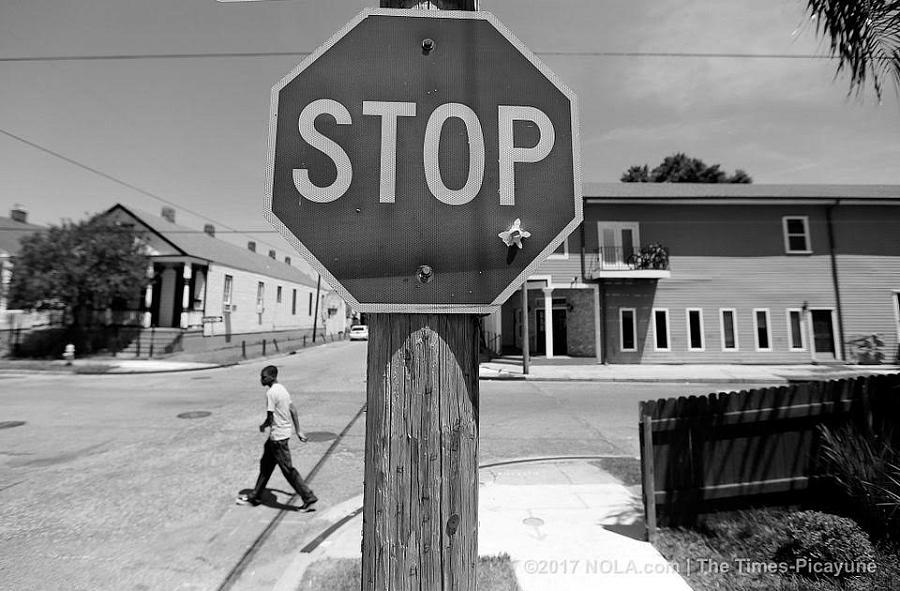For children growing up in New Orleans’ ‘Triangle of Death,’ the dangers take many forms

A bullet hole in a stop sign at the corner of Dryades and Fourth streets is a daily reminder of violence in the Central City neighborhood. (Photo by David Grunfeld, NOLA.com | The Times-Picayune)
Central City was one of the few New Orleans neighborhoods spared from the floodwaters that engulfed much of the city in 2005 when Hurricane Katrina made landfall and the levees failed. But in returning to their homes, the neighborhood’s residents faced a new threat: The storm destroyed many of the street corners and blocks that had been host to New Orleans’ rampant drug trade, forcing the remaining gangs to move into Central City.
With this mass concentration of drug traffickers came a bloody turf war, near-daily shootings and a rising body count. The results earned Central City the ominous moniker: “Triangle of Death.”
Our project aims to explore how the violence, which continues to this day, impacts the health and well-being of children born into this environment. The initial numbers are already staggering. The neighborhood’s residents, 72.4 percent of whom are African American, live in households where the average income is $36,000. The neighborhood’s children are four times as likely to grow up in single-parent homes.
For children in this neighborhood, violence and incarceration are inescapable facts of life. Last year, one in every 10 of the city’s 175 recorded murders took place in Central City. Overall, New Orleans recorded the fourth highest murder rate in the nation, and Louisiana’s incarceration rate again ranked as the world’s highest. In 2015, only one neighborhood — the heavily trafficked French Quarter — saw more arrests by police than Central City. The neighborhood had the most police stops that year.
All the while, children in Central City grow up in the shadows of one of New Orleans’ most affluent and iconic neighborhoods: The Garden District and its stately antebellum mansions. Garden District residents are 88.4 percent Caucasian and have an average household income of $151,000. Children in that neighborhood are eight times as likely to grow up in two-parent homes.
Separating the two starkly different neighborhoods is St. Charles Avenue, a four-lane thoroughfare lined with massive oak trees, bisected by the historic streetcar line and home to many of New Orleans’ Mardi Gras parades.
Part of our 2017 National Fellowship project hopes to examine the stark contrast in health outcomes for children in the two neighborhoods.
We’ll also look at the people and organizations that refuse to abandon hope for Central City. Fourteen years ago, Candince McMillian, then 22, bought a home at the corner of Fourth and Dryades streets. Admittedly naïve, the young African-American woman from a middle-class background had never met a drug dealer or heard a gunshot, much less seen a dead body. That all changed in her first few weeks living in Central City.
But instead of fleeing the troubled neighborhood, McMillian, the owner of a construction company, chose to stay and push for change. She purchased and renovated more than 20 blighted properties in the area, selling some and turning others into affordable rental units. She also founded Exodus Place, a youth mentorship nonprofit.
Through the eyes of McMillian, who has mentored or employed dozens of young people in the community, including many who have since been murdered, we hope to illustrate what it takes, on a personal level, to combat negative environmental factors that have been proven to harm children, physically, mentally and economically.
Several years ago, at the corner of First and Dryades streets, in the heart of the area this project will focus on, 2-year-old Jeremy Galmon was sitting in a car with his grandmother and two other children waiting for a second line parade to pass. Galmon stuck his head out the window at the same time two rival gangs opened fire at each other. A stray bullet hit him in the face.
A few days later, someone erected a white cross in a vacant lot near where he died. It is covered with dozens of tiny, multi-colored handprints, a makeshift monument for the murdered toddler.
“And a child shall lead them,” is written in black on the crossbar.
Central City is a community that has seen its share of violence and pain, and yet that cross stands as a clarion call of hope and resistance to those who say things can’t change. This project hopes to capture that spirit and document those who embody it.


